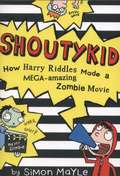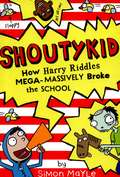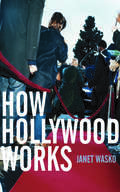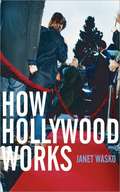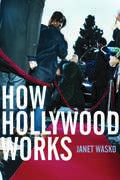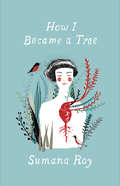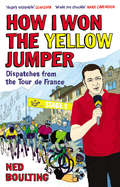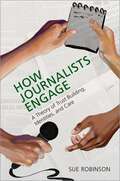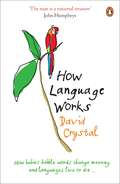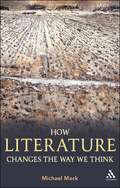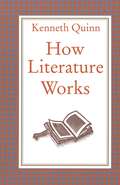- Table View
- List View
How Harry Riddles Made a Mega-Amazing Zombie Movie (Shoutykid, Book 1) (PDF)
by Simon MayleMeet the funniest kid in fiction! Hi there,My name is Harry Riddles and I am ten years old which my mum says is too young to have problems but she is WRONG.
How Harry Riddles Mega-Massively Broke the School (Shoutykid, Book 2) (PDF)
by Simon MayleThe funniest kid in fiction is back! Hi there, My name is Harry Riddles, and I live with my mum, my dad and my EVIL sister Charlotte.
How History Matters to Philosophy: Reconsidering Philosophy’s Past After Positivism (Routledge Studies in Contemporary Philosophy)
by Robert C. ScharffIn recent decades, widespread rejection of positivism’s notorious hostility toward the philosophical tradition has led to renewed debate about the real relationship of philosophy to its history. How History Matters to Philosophy takes a fresh look at this debate. Current discussion usually starts with the question of whether philosophy’s past should matter, but Scharff argues that the very existence of the debate itself demonstrates that it already does matter. After an introductory review of the recent literature, he develops his case in two parts. In Part One, he shows how history actually matters for even Plato’s Socrates, Descartes, and Comte, in spite of their apparent promotion of conspicuously ahistorical Platonic, Cartesian, and Positivistic ideals. In Part Two, Scharff argues that the real issue is not whether history matters; rather it is that we already have a history, a very distinctive and unavoidable inheritance, which paradoxically teaches us that history’s mattering is merely optional. Through interpretations of Dilthey, Nietzsche, and Heidegger, he describes what thinking in a historically determinate way actually involves, and he considers how to avoid the denial of this condition that our own philosophical inheritance still seems to expect of us. In a brief conclusion, Scharff explains how this book should be read as part of his own effort to acknowledge this condition rather than deny it.
How History Matters to Philosophy: Reconsidering Philosophy’s Past After Positivism (Routledge Studies in Contemporary Philosophy)
by Robert C. ScharffIn recent decades, widespread rejection of positivism’s notorious hostility toward the philosophical tradition has led to renewed debate about the real relationship of philosophy to its history. How History Matters to Philosophy takes a fresh look at this debate. Current discussion usually starts with the question of whether philosophy’s past should matter, but Scharff argues that the very existence of the debate itself demonstrates that it already does matter. After an introductory review of the recent literature, he develops his case in two parts. In Part One, he shows how history actually matters for even Plato’s Socrates, Descartes, and Comte, in spite of their apparent promotion of conspicuously ahistorical Platonic, Cartesian, and Positivistic ideals. In Part Two, Scharff argues that the real issue is not whether history matters; rather it is that we already have a history, a very distinctive and unavoidable inheritance, which paradoxically teaches us that history’s mattering is merely optional. Through interpretations of Dilthey, Nietzsche, and Heidegger, he describes what thinking in a historically determinate way actually involves, and he considers how to avoid the denial of this condition that our own philosophical inheritance still seems to expect of us. In a brief conclusion, Scharff explains how this book should be read as part of his own effort to acknowledge this condition rather than deny it.
How History Works: The Reconstitution of a Human Science (Routledge Approaches to History)
by Martin L. DaviesHow History Works assesses the social function of academic knowledge in the humanities, exemplified by history, and offers a critique of the validity of historical knowledge. The book focusses on history’s academic, disciplinary ethos to offer a reconception of the discipline of history, arguing that it is an existential liability: if critical analysis reveals the sense that history offers to the world to be illusory, what stops historical scholarship from becoming a disguise for pessimism or nihilism? History is routinely invoked in all kinds of cultural, political, economic, psychological situations to provide a reliable account or justification of what is happening. Moreover, it addresses a world already receptive to comprehensive historical explanations: since everyone has some knowledge of history, everyone can be manipulated by it. This book analyses the relationship between specialized knowledge and everyday experience, taking phenomenology (Husserl) and pragmatism (James) as methodological guides. It is informed by a wide literature sceptical of the sense academic historical expertise produces and of the work history does, represented by thinkers such as Schopenhauer, Nietzsche, Valéry, Anders and Cioran. How History Works discusses how history makes sense of the world even if what happens is senseless, arguing that behind the smoke-screen of historical scholarship looms a chaotic world-dynamic indifferent to human existence. It is valuable reading for anyone interested in historiography and historical theory.
How History Works: The Reconstitution of a Human Science (Routledge Approaches to History)
by Martin L. DaviesHow History Works assesses the social function of academic knowledge in the humanities, exemplified by history, and offers a critique of the validity of historical knowledge. The book focusses on history’s academic, disciplinary ethos to offer a reconception of the discipline of history, arguing that it is an existential liability: if critical analysis reveals the sense that history offers to the world to be illusory, what stops historical scholarship from becoming a disguise for pessimism or nihilism? History is routinely invoked in all kinds of cultural, political, economic, psychological situations to provide a reliable account or justification of what is happening. Moreover, it addresses a world already receptive to comprehensive historical explanations: since everyone has some knowledge of history, everyone can be manipulated by it. This book analyses the relationship between specialized knowledge and everyday experience, taking phenomenology (Husserl) and pragmatism (James) as methodological guides. It is informed by a wide literature sceptical of the sense academic historical expertise produces and of the work history does, represented by thinkers such as Schopenhauer, Nietzsche, Valéry, Anders and Cioran. How History Works discusses how history makes sense of the world even if what happens is senseless, arguing that behind the smoke-screen of historical scholarship looms a chaotic world-dynamic indifferent to human existence. It is valuable reading for anyone interested in historiography and historical theory.
How Hollywood Works
by Janet WaskoThis is a book about the US motion picture industry - its structure and policies, its operations and practices. It looks at the processes that are involved in turning raw materials and labor into feature films. It describes the process of film production, distribution, exhibition and retail - a process that involves different markets where materials, labor and products are bought and sold. In other words, this is a book about how Hollywood works - as an industry. How Hollywood Works: - offers an up-to-date survey of the policies and structure of the US film industry - looks at the relationship between the film industry and other media industries - examines the role of the major studios and the other 'players' - including, law firms, talent agents, and trade unions and guilds - provides access to hard-to-find statistical information on the industry While many books describe the film production and marketing process, they usually do so from an industry perspective and few look at Hollywood critically from within a more general economic, political and social context. By offering just such a critique, Janet Wasko's text provides a timely and essential analysis of how Hollywood works for all students of film and media.
How Hollywood Works (PDF)
by Janet WaskoThis is a book about the US motion picture industry - its structure and policies, its operations and practices. It looks at the processes that are involved in turning raw materials and labor into feature films. It describes the process of film production, distribution, exhibition and retail - a process that involves different markets where materials, labor and products are bought and sold. In other words, this is a book about how Hollywood works - as an industry. How Hollywood Works: - offers an up-to-date survey of the policies and structure of the US film industry.
How Hollywood Works (PDF)
by Janet WaskoThis is a book about the US motion picture industry - its structure and policies, its operations and practices. It looks at the processes that are involved in turning raw materials and labor into feature films. It describes the process of film production, distribution, exhibition and retail - a process that involves different markets where materials, labor and products are bought and sold. In other words, this is a book about how Hollywood works - as an industry. How Hollywood Works: - offers an up-to-date survey of the policies and structure of the US film industry - looks at the relationship between the film industry and other media industries - examines the role of the major studios and the other 'players' - including, law firms, talent agents, and trade unions and guilds - provides access to hard-to-find statistical information on the industry While many books describe the film production and marketing process, they usually do so from an industry perspective and few look at Hollywood critically from within a more general economic, political and social context. By offering just such a critique, Janet Wasko's text provides a timely and essential analysis of how Hollywood works for all students of film and media.
How I Became a Tree
by Sumana RoyAn exquisite, lovingly crafted meditation on plants, trees, and our place in the natural world, in the tradition of Robin Wall Kimmerer’s Braiding Sweetgrass and Annie Dillard’s Pilgrim at Tinker Creek “I was tired of speed. I wanted to live tree time.” So writes Sumana Roy at the start of How I Became a Tree, her captivating, adventurous, and self-reflective vision of what it means to be human in the natural world. Drawn to trees’ wisdom, their nonviolent way of being, their ability to cope with loneliness and pain, Roy movingly explores the lessons that writers, painters, photographers, scientists, and spiritual figures have gleaned through their engagement with trees—from Rabindranath Tagore to Tomas Tranströmer, Ovid to Octavio Paz, William Shakespeare to Margaret Atwood. Her stunning meditations on forests, plant life, time, self, and the exhaustion of being human evoke the spacious, relaxed rhythms of the trees themselves. Hailed upon its original publication in India as “a love song to plants and trees” and “an ode toall that is unnoticed, ill, neglected, and yet resilient,” How I Became a Tree blends literary history, theology, philosophy, botany, and more, and ultimately prompts readers to slow down and to imagine a reenchanted world in which humans live more like trees.
How I Won the Yellow Jumper: Dispatches from the Tour de France (Yellow Jersey Cycling Classics Ser.)
by Ned Boulting'Paris, 4 July 2003: My first Tour de France. I had never seen a bike race. I had only vaguely heard of Lance Armstrong. I had no idea what I was doing there. Yet, that day I was broadcasting live on television. I fumbled my way through a few platitudes, before summing up with the words, "...Dave Millar just missing out on the Yellow Jumper." Yes, the Yellow Jumper.'Follow Ned Boulting's (occasionally excruciating) experiences covering the world's most famous cycling race. His story offers an insider's view of what really goes on behind the scenes of the Tour. From up-close-and-personal encounters with Lance Armstrong to bewildered mishaps with the local cuisine, Ned's been there, done that and got the crumpled-looking t-shirt. Eight Tours on from Ned's humbling debut, he has grown to respect, mock, adore and crave the race in equal measure. What's more, he has even started to understand it. Includes How Cav Won the Green Jersey: Short Dispatches from the 2011 Tour de France
How Jewish is Jewish History? (The Littman Library of Jewish Civilization)
by Moshe RosmanWith great vigour and from the vantage point of long experience of writing and teaching Jewish history, Moshe Rosman treats the key questions that postmodernism raises for the writing of Jewish history. What is the relationship between Jewish culture and history and those of the non-Jews among whom Jews live? Can we-in the light of postmodernist thought-speak of a continuous, coherent Jewish People, with a distinct culture and history? What in fact is Jewish cultural history, and how can it be written? How does gender transform the Jewish historical narrative? How does Jewish history fit into the multicultural paradigm? Has Jewish history entered a postmodern phase? How can Jewish history utilize the methodologies of other disciplines to accomplish its task? All these are questions that Jewish historians need to think about if their work is to be taken seriously by mainstream historians and intellectuals, or indeed by educated Jews interested in understanding their own cultural and historical past. While engaging with the questions raised by postmodernists, the author adopts a critical stance towards their work. His basic claim is that it is possible to incorporate, judiciously, postmodern innovations into historical scholarship that is still based on documentary research and critical analysis. The resulting endeavor might be termed 'a reformed positivism'. Rosman presents a concentrated, coherent, cogent argument as to what considerations must be brought to bear on the writing of Jewish history today. By highlighting in one book the issues raised by postmodernism, How Jewish is Jewish History? provides those in the field with a foundation from which to discuss how it should be practiced in light of this generation's challenges. It is a valuable resource for students of Jewish history and historiography and a handy tool for scholars who must confront the issues aired here in their own more narrowly focused scholarly works.
How Journalists Engage: A Theory of Trust Building, Identities, and Care
by Sue RobinsonA unique theory of trust building in engagement journalism that proposes journalists move to an ethic of care as they prioritize listening and learning within communities instead of propping up problematic institutions. In How Journalists Engage, Sue Robinson explores how journalists of different identities, especially racial, enact trusting relationships with their audiences. Drawing from case studies, community-work, interviews, and focus groups, she documents a growing built environment around trust building and engagement journalism that represents the first major paradigm shift of the press's core values in more than a century. As Robinson shows, journalists are being trained to take on new roles and skillsets around listening and learning, in addition to normative routines related to being a watchdog and storyteller. She demonstrates how this movement mobilizes the nurturing of personal, organizational, and institutional relationships that people have with information, sources, news brands, journalists, and each other. Developing a new theory of trust building, Robinson calls for journalists to grapple actively with their own identities--especially the privileges, biases, and marginalization attached to them--and those of their communities, resulting in a more intentional and effective moral voice focused on justice and equity through the news practice of an ethic of care.
How Journalists Engage: A Theory of Trust Building, Identities, and Care
by Sue RobinsonA unique theory of trust building in engagement journalism that proposes journalists move to an ethic of care as they prioritize listening and learning within communities instead of propping up problematic institutions. In How Journalists Engage, Sue Robinson explores how journalists of different identities, especially racial, enact trusting relationships with their audiences. Drawing from case studies, community-work, interviews, and focus groups, she documents a growing built environment around trust building and engagement journalism that represents the first major paradigm shift of the press's core values in more than a century. As Robinson shows, journalists are being trained to take on new roles and skillsets around listening and learning, in addition to normative routines related to being a watchdog and storyteller. She demonstrates how this movement mobilizes the nurturing of personal, organizational, and institutional relationships that people have with information, sources, news brands, journalists, and each other. Developing a new theory of trust building, Robinson calls for journalists to grapple actively with their own identities--especially the privileges, biases, and marginalization attached to them--and those of their communities, resulting in a more intentional and effective moral voice focused on justice and equity through the news practice of an ethic of care.
How Language Shapes Relationships in Professional Sports Teams: Power and Solidarity Dynamics in a New Zealand Rugby Team
by Kieran FileWhile the topic of relationships in professional sports teams is gaining greater attention from researchers and practitioners, the role that coach and athlete language plays in shaping these relationships remains largely unexplored. This book addresses this gap by examining how every day, authentic language patterns used by coaches, captains and players shape relationships in a professional New Zealand rugby team. More specifically, through a discourse analysis of taken-for-granted ritual language practices in training sessions, team meetings and match-day interactions, the chapters of this book illustrate how coaches, captains and players shape particular interpersonal dynamics of power and solidarity between themselves in and through language and, in the process, reflect and reconstruct shared and underlying ideologies about how relationships of power and solidarity work in their team. Offering an evidence-based discussion of the silent and pervasive ideologies that underpin how relationships work in professional sports teams, this book extends research on this important topic by providing largely missing illustrations of consequential interpersonal dynamics that actively shape professional relationships in sports teams. Written in an approachable style, this book offers linguists, social scientists and sports practitioners a frame of reference for greater understanding of how language directly shapes relationships of power and solidarity.
How Language Shapes Relationships in Professional Sports Teams: Power and Solidarity Dynamics in a New Zealand Rugby Team
by Kieran FileWhile the topic of relationships in professional sports teams is gaining greater attention from researchers and practitioners, the role that coach and athlete language plays in shaping these relationships remains largely unexplored. This book addresses this gap by examining how every day, authentic language patterns used by coaches, captains and players shape relationships in a professional New Zealand rugby team. More specifically, through a discourse analysis of taken-for-granted ritual language practices in training sessions, team meetings and match-day interactions, the chapters of this book illustrate how coaches, captains and players shape particular interpersonal dynamics of power and solidarity between themselves in and through language and, in the process, reflect and reconstruct shared and underlying ideologies about how relationships of power and solidarity work in their team. Offering an evidence-based discussion of the silent and pervasive ideologies that underpin how relationships work in professional sports teams, this book extends research on this important topic by providing largely missing illustrations of consequential interpersonal dynamics that actively shape professional relationships in sports teams. Written in an approachable style, this book offers linguists, social scientists and sports practitioners a frame of reference for greater understanding of how language directly shapes relationships of power and solidarity.
How Language Works: How Babies Babble, Words Change Meaning, And Languages Live Or Die (Popular Penguins Series)
by David CrystalIn this fascinating survey of everything from how sounds become speech to how names work, David Crystal answers every question you might ever have had about the nuts and bolts of language in his usual highly illuminating way. Along the way we find out about eyebrow flashes, whistling languages, how parents teach their children to speak, how politeness travels across languages and how the way we talk show not just how old we are but where we’re from and even who we want to be.
How Languages Work: An Introduction To Language And Linguistics (PDF)
by Carol GenettiA new and exciting introduction to linguistics, this textbook presents language in all its amazing complexity, while guiding students gently through the basics. Students emerge with an appreciation of the diversity of the world's languages, as well as a deeper understanding of the structure of human language, the ways it is used, and its broader social and cultural context. Chapters introducing the nuts and bolts of language study (phonology, syntax, meaning) are combined with those on the 'functions' of language (discourse, prosody, pragmatics, and language contact), helping students gain a better grasp of how language works in the real world. A rich set of language 'profiles' help students explore the world's linguistic diversity, identify similarities and differences between languages, and encourages them to apply concepts from earlier chapter material. A range of carefully designed pedagogical features encourage student engagement, adopting a step-by-step approach and using study questions and case studies.
How Languages Work: An Introduction to Language and Linguistics (Second Edition) (PDF)
by Carol GenettiLanguage is a sophisticated tool which we use to communicate in a multitude of ways. Updated and expanded in its second edition, this book introduces language and linguistics - presenting language in all its amazing complexity while systematically guiding you through the basics. The reader will emerge with an appreciation of the diversity of the world's languages, as well as a deeper understanding of the structure of human language, the ways it is used, and its broader social and cultural context. Part I is devoted to the nuts and bolts of language study - speech sounds, sound patterns, sentence structure, and meaning - and includes chapters dedicated to the functional aspects of language: discourse, prosody, pragmatics, and language contact. The fourteen language profiles included in Part II reveal the world's linguistic variety while expanding on the similarities and differences between languages. Using knowledge gained from Part I, the reader can explore how language functions when speakers use it in daily interaction. With a step-by-step approach that is reinforced with well-chosen illustrations, case studies, and study questions, readers will gain understanding and analytical skills that will only enrich their ongoing study of language and linguistics.
How Literature Changes the Way We Think
by Michael MackThe capacity of the arts and the humanities, and of literature in particular, to have a meaningful societal impact has been increasingly undervalued in recent history. Both humanists and scientists have tended to think of the arts as a means to represent the world via imagination. Mack maintains that the arts do not merely describe our world but that they also have the unique and underappreciated power to make us aware of how we can change accustomed forms of perception and action. Mack explores the works of prominent writers and thinkers, including Nietzsche, Foucault, Benjamin, Wilde, Roth, and Zizek, among others, to illustrate how literature interacts with both people and political as well as scientific issues of the real world. By virtue of its distance from the real world-its virtuality-the aesthetic has the capability to help us explore different and so far unthinkable forms of action and thereby to resist the repetition and perpetuation of harmful practices such as stereotyping, stigma, exclusion, and the exertion of violence.
How Literature Changes the Way We Think
by Michael MackThe capacity of the arts and the humanities, and of literature in particular, to have a meaningful societal impact has been increasingly undervalued in recent history. Both humanists and scientists have tended to think of the arts as a means to represent the world via imagination. Mack maintains that the arts do not merely describe our world but that they also have the unique and underappreciated power to make us aware of how we can change accustomed forms of perception and action. Mack explores the works of prominent writers and thinkers, including Nietzsche, Foucault, Benjamin, Wilde, Roth, and Zizek, among others, to illustrate how literature interacts with both people and political as well as scientific issues of the real world. By virtue of its distance from the real world-its virtuality-the aesthetic has the capability to help us explore different and so far unthinkable forms of action and thereby to resist the repetition and perpetuation of harmful practices such as stereotyping, stigma, exclusion, and the exertion of violence.
How Literature Plays with the Brain: The Neuroscience of Reading and Art
by Paul B. Armstrong"Literature matters," says Paul B. Armstrong, "for what it reveals about human experience, and the very different perspective of neuroscience on how the brain works is part of that story." In How Literature Plays with the Brain, Armstrong examines the parallels between certain features of literary experience and functions of the brain. His central argument is that literature plays with the brain through experiences of harmony and dissonance which set in motion oppositions that are fundamental to the neurobiology of mental functioning. These oppositions negotiate basic tensions in the operation of the brain between the drive for pattern, synthesis, and constancy and the need for flexibility, adaptability, and openness to change.The challenge, Armstrong argues, is to account for the ability of readers to find incommensurable meanings in the same text, for example, or to take pleasure in art that is harmonious or dissonant, symmetrical or distorted, unified or discontinuous and disruptive.How Literature Plays with the Brain is the first book to use the resources of neuroscience and phenomenology to analyze aesthetic experience. For the neuroscientific community, the study suggests that different areas of research—the neurobiology of vision and reading, the brain-body interactions underlying emotions—may be connected to a variety of aesthetic and literary phenomena. For critics and students of literature, the study engages fundamental questions within the humanities: What is aesthetic experience? What happens when we read a literary work? How does the interpretation of literature relate to other ways of knowing?
How Literature Plays with the Brain: The Neuroscience of Reading and Art
by Paul B. Armstrong"Literature matters," says Paul B. Armstrong, "for what it reveals about human experience, and the very different perspective of neuroscience on how the brain works is part of that story." In How Literature Plays with the Brain, Armstrong examines the parallels between certain features of literary experience and functions of the brain. His central argument is that literature plays with the brain through experiences of harmony and dissonance which set in motion oppositions that are fundamental to the neurobiology of mental functioning. These oppositions negotiate basic tensions in the operation of the brain between the drive for pattern, synthesis, and constancy and the need for flexibility, adaptability, and openness to change.The challenge, Armstrong argues, is to account for the ability of readers to find incommensurable meanings in the same text, for example, or to take pleasure in art that is harmonious or dissonant, symmetrical or distorted, unified or discontinuous and disruptive.How Literature Plays with the Brain is the first book to use the resources of neuroscience and phenomenology to analyze aesthetic experience. For the neuroscientific community, the study suggests that different areas of research—the neurobiology of vision and reading, the brain-body interactions underlying emotions—may be connected to a variety of aesthetic and literary phenomena. For critics and students of literature, the study engages fundamental questions within the humanities: What is aesthetic experience? What happens when we read a literary work? How does the interpretation of literature relate to other ways of knowing?
How Literature Works
by Kenneth QuinnIn How Literature Works important issues of literary theory are vividly illustrated by application to a wide variety of texts, many quoted and discussed at length. The theoretical aspects covered include the structural characteristics of literary texts, the psychology of the reading process and the social function of literature. The book also deals with such general questions as the relationship between literary texts and `objective' prose and the relationship between poems written to work as songs and those in which the lyric form is used to develop an argument: the singing and the speaking voice.
How Literatures Begin: A Global History
by Joel B. Lande & Denis FeeneyA comparative history of the practices, technologies, institutions, and people that created distinct literary traditions around the world, from ancient to modern timesLiterature is such a familiar and widespread form of imaginative expression today that its existence can seem inevitable. But in fact very few languages ever developed the full-fledged literary cultures we take for granted. Challenging basic assumptions about literatures by uncovering both the distinct and common factors that led to their improbable invention, How Literatures Begin is a global, comparative history of literary origins that spans the ancient and modern world and stretches from Asia and Europe to Africa and the Americas.The book brings together a group of leading literary historians to examine the practices, technologies, institutions, and individuals that created seventeen literary traditions: Chinese, Japanese, Korean, Indian, Greek, Latin, Hebrew, Syriac, Arabic, English, Romance languages, German, Russian, Latin American, African, African American, and world literature. In these accessible accounts, which are framed by general and section introductions and a conclusion by the editors, literatures emerge as complex weaves of phenomena, unique and deeply rooted in particular times and places but also displaying surprising similarities. Again and again, new literatures arise out of old, come into being through interactions across national and linguistic borders, take inspiration from translation and cultural cross-fertilization, and provide new ways for groups to imagine themselves in relation to their moment in history.Renewing our sense of wonder for the unlikely and strange thing we call literature, How Literatures Begin offers fresh opportunities for comparison between the individual traditions that make up the rich mosaic of the world’s literatures.The book is organized in four sections, with seventeen literatures covered by individual contributors: Part I: East and South Asia: Chinese (Martin Kern), Japanese (Wiebke Denecke), Korean (Ksenia Chizhova), and Indian (Sheldon Pollock); Part II: The Mediterranean: Greek (Deborah Steiner), Latin (Joseph Farrell), Hebrew (Jacqueline Vayntrub), Syriac (Alberto Rigolio), and Arabic (Gregor Schoeler); Part III: European Vernaculars: English (Ingrid Nelson), Romance languages (Simon Gaunt), German (Joel Lande), and Russian (Michael Wachtel); Part IV: Modern Geographies: Latin American (Rolena Adorno), African (Simon Gikandi), African American (Douglas Jones), and world literature (Jane O. Newman).
